 Danke: 0
Danke: 0
Ergebnis 1 bis 10 von 10
-
- 23.12.2012, 14:20
- #1
Zum ersten Mal haben wir alle das Surface Pro wohl im Juni gesehen, auf der Surface-Veranstaltung von Microsoft am 18. Juni 2012 in Hollywood (Milk Studios, Los Angeles, North Cahuenga). Steve Ballmer, Steven Sinofsky, Michael Angiulo und Panos Panay zeigten das Surface RT und das Surface Pro und erklärten u.a. den Kick Stand, die Stiftnutzung und das Touch Cover und Type Cover.
http://www.youtube.com/watch?v=g-Q3exhMUGs
Was am Surface Pro sehr interessant zu sehen ist, ist die Art der Kühlung des Ivy Bridge i5-Prozessors und der Intel HD 4000 GPU. Michael Angiulo sprach von Perimeter venting, einer Art Rundum-Kühlung:
It's a groove ringing the whole tablet… You never block it with your hands. You never even feel it.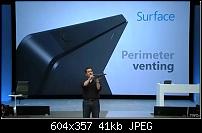
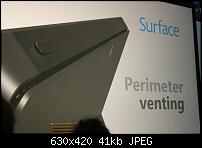
Deshalb ist das Surface Pro mit seinen 13,5 mm Dicke u.a. auch deshalb 4,2 mm dicker als das Surface RT.
Michael sprach aber auch davon, wie man das Actice cooling in einen Tablet-PC integriert:
http://www.youtube.com/watch?v=Ep9bem6O9r4
Was nun sehr interessant zu wissen wäre: Ist das alles zur Kühlung? Einfach eine Rundum-Öffnung? Oder ist da doch eine Art Luftleitsystem an die Peripherie, wo davor im Gerät ein aktiver, treibender Ventilator sitzt?
-----
Quellen:
Read more at http://venturebeat.com/2012/06/18/mi...6947l1DQU5O.99To deal with thermals, the Surface has what Microsoft is calling perimeter venting, where there is a tiny slit all around the frame that allows for air to flow freely through the tablet. Based on Sandy Bridge processor (Intel’s last-generation of CPUs) heat production would pose a serious problem for a small, enclosed space like a tablet. Microsoft didn’t state much about perimeter venting, but it’s likely that the venting system is designed to add structure to the frame while simultaneously keeping the handheld cool.
Mehr hier: http://readwrite.com/2012/06/20/why-...usiness-tabletThe Heat Index?
Tablets are a godsend on the road, and the Surface Pro should be a perfect one-size-fits-all tool for business travelers, providing both entertainment and full access to their standard work tools. But there’s a potential problem: heat.
Remember, notebooks based on Intel Core chips are notorious for running hot. Microsoft said it has designed an innovative cooling system that vents the Core i5’s heat via the “seam” so that the bottom of the device stays cool. Until we can test how well that works, there’s a real possibility that the Core i5's speed will be severely restricted to keep the device from getting too warm. Or it may turn out that professionals will have to use the Surface Pro primarily in kickstand mode to avoid setting fire to their laptops and desktops.
Readwrite.com spekuliert, dass die Luft, die vom offenen Rundum-Rand in das Surface Pro einströmt, den Boden des Gerätes kühlt und Microsoft eventuell auch die i5-CPU herunter taktet, um zu viel Wärme zu verhindern.
Ob dieses Konzept also wirklich nur passiv, also ohne Ventilator, arbeitet?

Manfred
-
 Bin neu hier
Bin neu hier
- 23.12.2012, 20:20
- #2
ich glaube kaum, dass es durch die bauform möglich ist einen i5 bei voller Auslastung lediglich passiv zu kühlen.
Es gibt bei einigen i5 ultrabooks die Möglichkeit, die cpu bei bedarf auf Ca. 800mhz zu drosseln, wodurch höhere Laufzeiten möglich sind und der Lüfter still bleibt (ich meine bei dem Zenbook gibt's da nen Asus eigenes widget vorinstalliert)
nun könnte ich mir maximal vorstellen, dass man durchs "perimeter venting" eine höhere Taktrate (vllt 900mhz oder so) setzen kann, ohne das der Lüfter anspringt.
-
- 25.12.2012, 12:57
- #3
Dieses Zitat:
Fand ich hier:Handling the heat put out by the Intel chip is what Microsoft calls "perimeter venting" or a series of integrated vents encircling the edge of the bezel, which itself is beveled.
http://appleinsider.com/articles/12/..._8_tablet.html
Hier wird sogar von einer Serie von Ventilatoren gesprochen...
-----
Steve Ballmer wiederum sagte dazu:
-----The Surface has perimeter venting which Ballmer described as a "groove around the edge of the case which allows air to be vented so you never block it with your Hands.
Read more: http://www.news.com.au/technology/ta...#ixzz2G43SUdkC
ZDNET sagt dazu:
http://www.zdnet.com/blog/bott/what-...s-surface/5149•There's a slim vent that runs around the entire outer edge of the Surface for Windows 8 Pro. That vent allows heat to dissipate (quietly, one hopes, with little or no fan noise) no matter where you're holding the device.
-----
Und noch eine Info:
http://www.slashgear.com/microsoft-s...s-on-18234512/Microsoft added a unique vent system around the device that will keep heat to a minimum without being blocked by hands or while resting flat on a tablet or bed — these vents cause a slight rough edge though.
-----
Hoffnung auf passive Kühlung:
http://www.gamona.de/hardware/micros...,2170920.html#Während beim Surface mit Windows RT ein Tegra-3-Chip mit ARM-Architektur eingesetzt wird, arbeitet im Surface mit Windows 8 einer Intel Ivy-Bridge Core i5 CPU. Um diese zu kühlen setzt Microsoft auf eine passive Kühlung.
-----
Kein Platz für Ventilator:
http://www.thewindowsclub.com/amazin...surface-tabletPerimeter Venting : Surface running Intel processor with Windows 8 Pro, is a full-fledged PC. This Surface is powered by an Intel 3rd Gen core i5 processor,22 nm Ivy Bridge , a faster CPU, a GPU that has doubled the 3D graphics throughput using less power than todays core i5s. But still these require proper cooling. And with that power comes the unique design challenge of designing a PC. There’s no obvious place to put a vent. And still the Surface is cool enough to hold by hand all day long – due to its ingenious cooling design.
The design solution is Perimeter Venting. The Surface has a groove all the way outside of the case. This allows air to be uniformly distributed across the entire PC and it never blocks it with your hand. You will feel comfortable holding it in your hand.

Manfred
-
 Bin neu hier
Bin neu hier
- 29.12.2012, 23:32
- #4
Ich denk es wär unrealistisch zu denken, dass das Surface Pro ohne Lüfter auskommt. So wie ich das ganze System verstanden hab verhindert das Perimeter Venting, dass an einem Punkt des Geräts warme bis heisse Luft ausströmt (was bei bisherigen, gekühlten Tablets der Fall ist) und sehr unangenehm ist zu halten.
Auch soll es wohl dazu dienen die Wärme des Gerätes uniformer zu verteilen und weniger Hotspots fühlbar zu lassen.
Sollte das ganze passiv sein, dann wärs echt ein big deal!
-
blaubarschboy94 Gast
Meiner Erfahrung nach dürfte das sehr sehr schwer sein einen i5 PASSIV zu kühlen in diesem kleinem Gehäuse. Müsste ich raten würde ich behaupten, dass es eben diese mehrere kleinen Ventilatoren / Lüfter sind, das Teil keine DIREKTE warumluft-ausstrahlung hat, sondern eben verteilt und man es an keiner Stelle spürt oder verhindert, dass weniger warme Luft eindringt.
-
- 04.01.2013, 22:25
- #6
Im US-Shop von Microsoft habe ich folgende schönen Bilder zu Microsoft Surface Pro gefunden, wo man auch die Venting line (Luftauslass) relativ gut sieht:
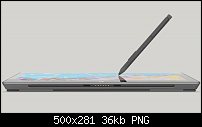
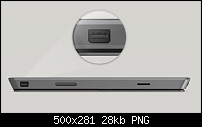
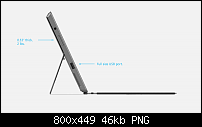
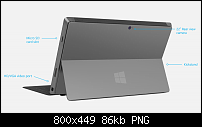
http://www.microsoft.com/Surface/en-...ows-8-pro/home
Im ersten Bild, wo man unten den Magnetanschluss für die Tastatur sieht, und in Bild 3 und 4 links und rechts, da, wo man den Ständer einklappt, ist diese Venting line unterbrochen!

Manfred
-
 Bin hier zuhause
Bin hier zuhause
- 05.01.2013, 12:51
- #7
Ich tippe drauf, genau da unten saugt er in der Mitte an und verteilt das dann gleichmäßig über den Umfang! Also doch mit Lüfter, ich kann mir einfach nicht vorstellen das so ein Schlitz ohne aktiv Luft zu fördern soviel bringt!
-
 Gehöre zum Inventar
Gehöre zum Inventar
- 05.01.2013, 18:42
- #8
Ziel der neuen Kühllösung ist, dass man, egal wie man das Tablet hält, die Lüftungsöffnung nicht blockieren kann. Von einer passiven Lösung war nie die Rede und das wäre sicher beworben worden. Es wird lediglich gesagt, dass man den Luftstrom nichtmal richtig fühlen kann weil er so stark verteilt wird und nicht nur an einer Stelle aus dem Gehäuse kommt. Das wird aber sicher nur den Normalbetrieb betreffen, wer das Surface längere Zeit an seine Leistungsgrenze bringt der wird sicher auch merken, dass der Luftstrom stärker wird.
-
- 09.01.2013, 21:29
- #9
ZDNET und Andere konnten das Surface Pro auf der CES 2013 in Las Vegas in einem abgelegenen Raum von Microsoft bis 45 Minuten austesten. Infos gab es keine dazu.
MINYANVILLE sagt über das leise Surface Pro Venting-System:
However, tech-heads seemed most interested in the Surface Pro’s new peripheral venting system. Instead of simply pushing out of the device with a single fan, Microsoft utilized a ventilation strip that runs around the edge of the entire tablet. This new method evenly ejects heat, and prevents hotspots from building up, even when demanding programs are running. Better still, the design allows its fan to run silently and makes the tablet seem thinner than it really is. The team from ZDNet is interested in fully testing this feature later; if it can handle an exceptionally heavy CPU load, it’s possible that this innovation will be utilized in future tablets to come.
Read more: http://www.minyanville.com/sectors/t...#ixzz2HVmJhl8E
ZDNET:
Link: http://www.zdnet.com/hands-on-with-m...ro-7000009572/Peripheral venting
The Surface Pro runs surprisingly cool, thanks to its peripheral venting. Heat isn't pushed out of a single vent by a fan, but is evenly ejected via a slot that surrounds the entire tablet. It's an interesting approach, and one we'll need to spend more time exploring — especially under heavy CPU load. The vent also makes the Surface Pro seem thinner than it is, drawing the eye away from the rest of the case.

Manfred
-
- 12.01.2013, 05:21
- #10
Noch ein CES 2013 Test des Surface Pro, wo sogar von zwei Ventilatoren gesprochen wird:
Link: http://www.pcworld.com/article/20246...-from-ces.htmlUnlike the completely passively cooled Surface RT, the Surface Pro has two built-in fans. During the demo, the fans were perfectly quiet when I was using the Pro as a conventional tablet. I was warned the sound levels would increase during game play, but Bulletstorm was loud enough to drown out the fans (that is, if they were increasing in volume at all).
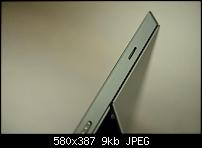

Manfred
Ähnliche Themen
-
Surface Touchcover ohne ... Touch?!
Von How4rd im Forum Microsoft Surface RTAntworten: 1Letzter Beitrag: 01.11.2012, 09:03 -
Unterschide surface / pro
Von sam333 im Forum Microsoft Surface RTAntworten: 20Letzter Beitrag: 10.10.2012, 22:23
Besucher haben diese Seite mit folgenden Suchbegriffen gefunden:
,















Gaming in der eigenen Cloud - VPS...